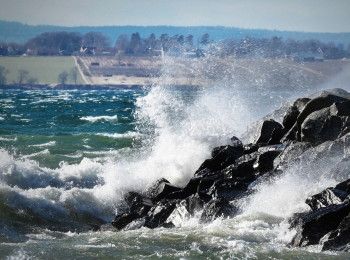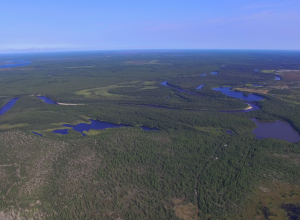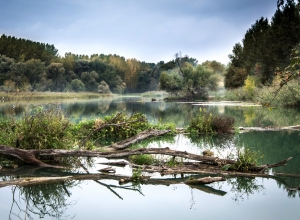How do algae react to storms and a warming climate ?
Lakes are home to many different species, but they also provide us beneficial services, such as drinking water, or a place to swim. Together with aquatic plants, phytoplankton (more commonly known as "algae") form the basis of the food web in lakes: they need carbon, nutrients, and sunlight to grow, and they are grazed upon by animalistic plankton (tiny animals), which are again eaten by fish. As such, phytoplankton take up a similar place in the lake ecosystem as for example grasses in grasslands. Increased amounts of nutrients in a lake, for example due to runoff from agricultural lands, can lead to excessive growth of phytoplankton, so called "blooms". These blooms may be toxic, causing health risks for cattle, pets, or even humans, and they often have other undesirable consequences for us. Therefore, monitoring and understanding phytoplankton dynamics is an important consideration for lake management.
Weather conditions are important for phytoplankton growth; phytoplankton need sunlight to grow and tend to grow faster under warmer conditions, and we already mentioned that they need a certain amount of nutrients. But there is another important factor that one needs to take into account: mixing dynamics. In deep lakes (more than 10 m deep), mostly during summer, there is a phenomenon called stratification. If you ever went diving into a lake in summer, you might have noticed that it suddenly got a lot colder below a certain depth! This happens because warmer water weighs less than cold water, hence warmer water floats on top of colder water during the summer month. "Stratification" helps phytoplankton to stay near the surface and enhance their survival; if phytoplankton - who can’t swim - sink too deep into the lake, it is too dark for them to grow. When a lake is stratified, water circulates mostly just in the warm top layer, instead of through the entire lake, preventing phytoplankton from sinking too deep. The deep water, however, is still rich in nutrients, and phytoplankton do not have access to those until the water is mixed upwards again when stratification ends.
Climate change, through warmer water temperatures and longer periods of stratification, can intensify phytoplankton growth. But climate change comprises more than warmer air temperatures alone; according to the IPCC reports, the intensity and frequency of extreme weather events is changing as well. As part of an international research team, we looked at the effect of one of these extreme events - high wind speeds - on phytoplankton. Storms with high wind speeds (hereafter called "wind events") cause mixing in the lake, which can mix phytoplankton over a large depth, where they grow less due to darkness. However, this mixing can also mix the nutrient-rich water deep in the lake into the surface water layers, where they become available for algae. We can rarely predict how phytoplankton will react to wind events: in some lakes (or times of the year) we see increases in phytoplankton concentration after periods with strong wind, while in other lakes we see decreases. Moreover, we do not yet know how climate warming factors into this. As lakes warm up, stratification starts earlier in the year, and the temperature difference between top and bottom waters tends to become larger, which provides more resistance to wind mixing. It may therefore be very well possible that an identical wind event has a different effect now, than it will have in 30 years time.
We wanted to discover which lake factors determine how phytoplankton reacts to wind mixing during the stratified period, and also how the effect of wind on phytoplankton might change under the influence of climate warming. But real experiments in the lab or the lake are very difficult or even impossible on such a scale, and we wanted to test many different scenarios. We therefore opted to use a computer model. Such a model can simulate the vertical temperature structure in a lake based on weather conditions (such as wind speed, air temperature, and incoming sunlight) and can also estimate phytoplankton growth at multiple depths, based on available nutrients and sunlight. As a study case, we simulated a lake with a long and complete data record: Lake Erken in Sweden. This lake is located about 60 km north-east of Stockholm, covers 24 km2, has a maximum depth of 21 m, and it contains a moderate amount of nutrients.
The simulations suggested that wind speed, surface layer depth, surface water temperature, nutrient concentration, and incoming sunlight changed how phytoplankton responded to a wind event. For example, when the surface layer was deeper than 8 m, the mixing did not reach deep enough to cause large changes in the phytoplankton. Under most conditions, events with average daily wind speeds of 18-36 km/h led to increases in phytoplankton concentration compared to simulations with low wind speeds, but when average wind speeds exceeded 36 km/h, the phytoplankton concentration decreased again. Last but not least, incoming sunlight had a strong effect: if there was more sunlight, wind events caused a stronger boost in phytoplankton concentration.
The simulations under a future warmer climate showed, as expected, different lake conditions: warmer water temperature, a shallower depth of the surface layer, more nutrients in the deeper water layers, and higher summer averages of phytoplankton concentrations. However, the response of phytoplankton to wind events did not seem to change strongly; an event with a certain wind speed had, on average, the same effect in the simulations with the present climate as in the simulations with the warmer climate.
Altogether, this study (link to article) gave more insights into the complex relation between wind speed and phytoplankton growth. This may help scientists to better predict phytoplankton blooms in lakes, and it can be helpful to lake managers as well. The chosen methodology - using a computer simulation model - is of course a simplification of reality, but it enables testing hypotheses that would be impossible to test in a physical environment. As the frequency and intensity of extreme weather events (storms, but also heatwaves and droughts) is predicted to change in a future climate, it is important to better understand their impact on our lakes.
[Ce texte est aussi disponible en français.]
Jorrit Mesman
Jorrit Mesman has obtained the BSc Soil, water, atmosphere and the MSc Earth and Environment at the Wageningen University in the Netherlands. He recently graduated from the University of Geneva, where his doctoral research focused on modelling the combined effects of extreme weather and climate warming on lakes. He has now started a position as post-doctoral researcher at Uppsala University in Sweden.
Ariadna Fossas Tenas
Ariadna Fossas Tenas has a PhD in mathematics from the University of Grenoble. She is a research assistant at the Nonlinearity and Climate Group of the Institute for Environmental Sciences, where she works on the paradoxical effect of altruism networks in common good issues. She is interested in science outreach and finds it enriching to discuss with colleagues from other disciplines about their research.




